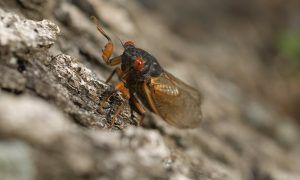Derek Skillings in Aeon:
 Cicadas might be a pest, but they’re special in a few respects. For one, these droning insects have a habit of emerging after a prime number of years (7, 13, or 17). They also feed exclusively on plant sap, which is strikingly low in nutrients. To make up for this deficiency, cicadas depend on two different strains of bacteria that they keep cloistered within special cells, and that provide them with additional amino acids. All three partners – the cicadas and the two types of microbes – have evolved in concert, and none could survive on its own. These organisms together make up what’s known as a holobiont: a combination of a host, plus all of the resident microbes that live in it and on it. The concept has taken off within biology in the past 10 years, as we’ve discovered more and more plants and animals that are accompanied by a jostling menagerie of internal and external fellow-travellers. Some of the microorganisms kill each other with toxins, while others leak or release enzymes and nutrients to the benefit of their neighbours. As they compete for space and food, cohabiting microbes have been found to affect the nutrition, development, immune system and behaviour of their hosts. The hosts, for their part, can often manipulate their resident microbiota in many ways, usually via the immune system.
Cicadas might be a pest, but they’re special in a few respects. For one, these droning insects have a habit of emerging after a prime number of years (7, 13, or 17). They also feed exclusively on plant sap, which is strikingly low in nutrients. To make up for this deficiency, cicadas depend on two different strains of bacteria that they keep cloistered within special cells, and that provide them with additional amino acids. All three partners – the cicadas and the two types of microbes – have evolved in concert, and none could survive on its own. These organisms together make up what’s known as a holobiont: a combination of a host, plus all of the resident microbes that live in it and on it. The concept has taken off within biology in the past 10 years, as we’ve discovered more and more plants and animals that are accompanied by a jostling menagerie of internal and external fellow-travellers. Some of the microorganisms kill each other with toxins, while others leak or release enzymes and nutrients to the benefit of their neighbours. As they compete for space and food, cohabiting microbes have been found to affect the nutrition, development, immune system and behaviour of their hosts. The hosts, for their part, can often manipulate their resident microbiota in many ways, usually via the immune system.
You yourself are swarming with bacteria, archaea, protists and viruses, and might even be carrying larger organisms such as worms and fungi as well. So are you a holobiont, or are you just part of one? Are you a multispecies entity, made up of some human bits and some microbial bits – or are you just the human bits, with an admittedly fuzzy boundary between yourself and your tiny companions? The future direction of medical science could very well hinge on the answer.
The American evolutionary theorist Lynn Margulis, who popularised the theory of symbiosis, first coined the term ‘holobiont’ in 1991. She was interested in long-term, tightly integrated associations such as those evident in lichens – the crusty-looking growths found on rocks and trees, made up of fungus conjoined with algae. Margulis thought that there was a tight analogy between an egg and a sperm coming together to form a new organism, and the coming together of two species to form a new symbiotic consortium, which she called a holobiont.
More here.
